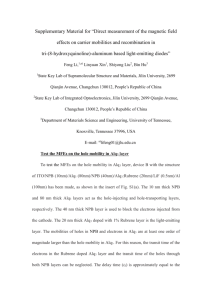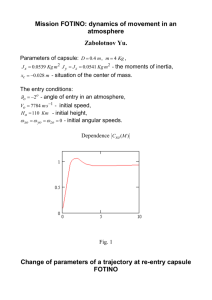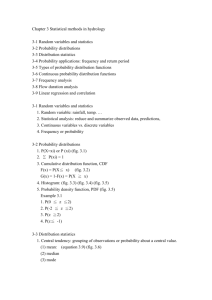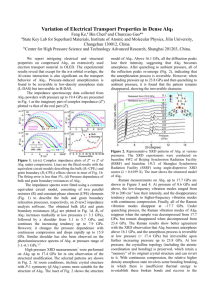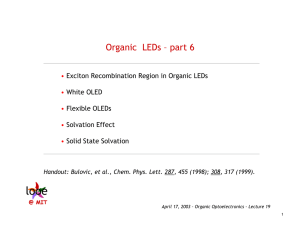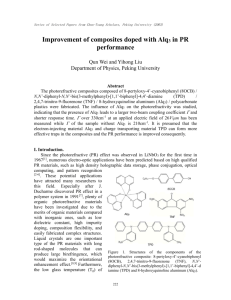JAP_Supplementary_Diffusion Manuscript_YNM
advertisement
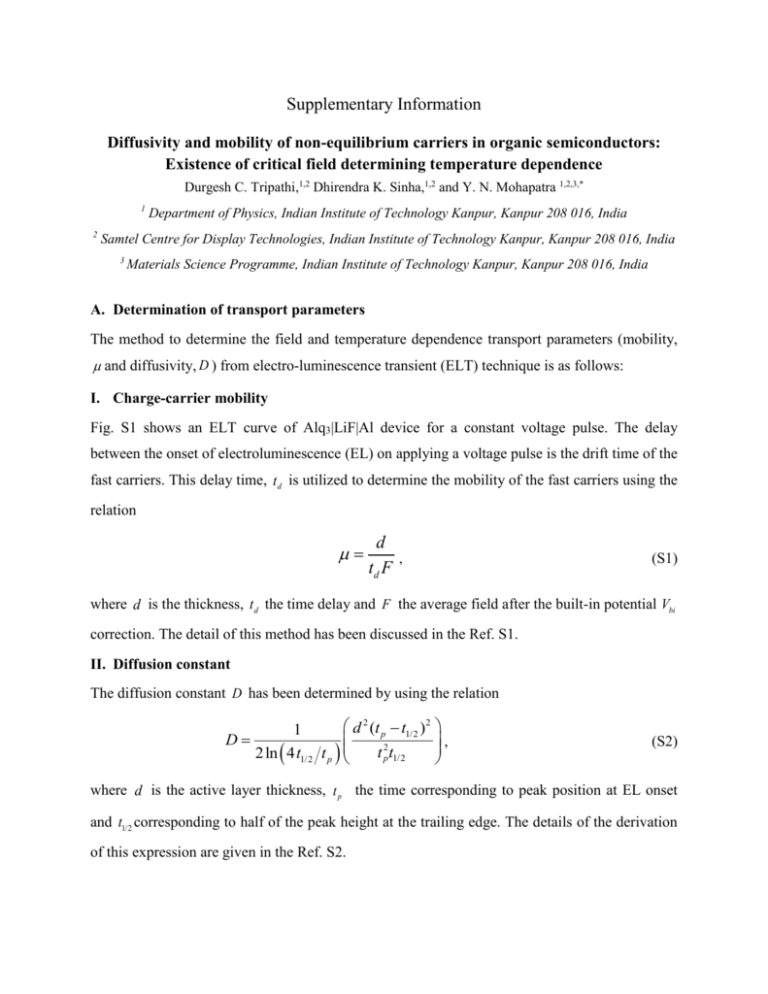
Supplementary Information
Diffusivity and mobility of non-equilibrium carriers in organic semiconductors:
Existence of critical field determining temperature dependence
Durgesh C. Tripathi,1,2 Dhirendra K. Sinha,1,2 and Y. N. Mohapatra 1,2,3,*
1
2
Department of Physics, Indian Institute of Technology Kanpur, Kanpur 208 016, India
Samtel Centre for Display Technologies, Indian Institute of Technology Kanpur, Kanpur 208 016, India
3
Materials Science Programme, Indian Institute of Technology Kanpur, Kanpur 208 016, India
A. Determination of transport parameters
The method to determine the field and temperature dependence transport parameters (mobility,
and diffusivity, D ) from electro-luminescence transient (ELT) technique is as follows:
I. Charge-carrier mobility
Fig. S1 shows an ELT curve of Alq3|LiF|Al device for a constant voltage pulse. The delay
between the onset of electroluminescence (EL) on applying a voltage pulse is the drift time of the
fast carriers. This delay time, t d is utilized to determine the mobility of the fast carriers using the
relation
d
td F
,
(S1)
where d is the thickness, t d the time delay and F the average field after the built-in potential Vbi
correction. The detail of this method has been discussed in the Ref. S1.
II. Diffusion constant
The diffusion constant D has been determined by using the relation
d 2 (t p t1/2 )2
1
D
,
t 2pt1/2
2ln 4 t1/2 t p
(S2)
where d is the active layer thickness, t p the time corresponding to peak position at EL onset
and t1/2 corresponding to half of the peak height at the trailing edge. The details of the derivation
of this expression are given in the Ref. S2.
The time corresponding to peak position ( t p ), and half of the peak height ( t1/2 ) at the trailing edge
has been measured from the ELT curves normalized with respect to the steady state level as
shown in Fig. S2. The details of this technique have been already discussed in the Ref. S2.
Voltage (V)
8
6
4
2
EL (arb.units)
0
1.2
0.8
0.4
td
0.0
0
5
10
Time (s)
15
Fig. S1. A typical ELT curve for the Alq3|LiF|Al device depicting the delay in the onset of EL on
the application of voltage pulse.
tp
Normalized EL Intensity
3
t1/2
2
1
0
0
10
20
Time (s)
30
40
Fig. S2. A typical peak appearing on the EL onset. The labeling show the time corresponding to
the peak position ( t p ), and half of the peak height ( t1/2 ) at the trailing edge.
B. Methodology of field correction and determination of transport parameters
The shape of the field dependence of D is nearly same at all temperatures for Alq3 except that
the minima ( Dmin ) is shifted linearly to the higher field for the lower temperatures. By linearly
shifting the Dmin field with respect to the room temperature (RT), all the curves collapse on each
other as shown in the inset of the lower panel of Fig. 2. This procedure of linear shift has been
defined as the ‘shift normalization’. The field corresponding to Dmin has been defined as a critical
field, Fc .
300K
275K
250K
225K
-6
2 -1
D (cm s )
10
-7
10
1125
1250
1/2
1375
1500
-1 1/2
F (Vcm )
Fig. S3. The field dependence of D for Alq3/LiF/Al devices measured at different temperatures.
The arrows show the critical field corresponding to Dmin at different temperatures.
The field dependence of D in case of PFO is different from that of Alq3. The line shape of D is
similar at all the temperatures, but the minima in D has not been observed. However, D
increases sharply beyond a threshold voltage, as shown in lower panel of Fig. 3. By linearly
shifting the threshold voltage for lower temperature with respect to the RT, all the curves
collapse as seen in case of Alq3. In this case Fc is the field corresponding to the threshold
voltage.
I. Field normalized mobility ( )
The field normalized mobility ( ) has been obtained using Eq. (S1) wherein the field is
replaced by the corresponding corrected field. That is, when the field is corrected by shiftnormalization with respect to the RT (300 K), as done for D , the P-F dependence of mobility has
been obtained and shown in Fig. 7(a) & (b) for the Alq3 and the PFO, respectively. Similarly,
when we carry out correction with Fc , the negative P-F dependence of has been obtained
which is depicted in Fig. 8(a) & (b) for the Alq3 and the PFO, respectively. By such field
corrections, we obtained the temperature independent as shown in Fig. 7 and 8.
II. Extraction of parameters from the normalized mobility ( )
In the Gaussian Disorder Model (GDM) for very dilute non-interacting case, the temperature and
field dependence of mobility is given as [S3]
2
2
GDM ( F , T ) o, exp
F ,
exp C
3k BT
k BT
2
2
(S3)
where and are the GDM parameters corresponding to the diagonal and the off-diagonal
disorder and o , is the mobility at zero field and infinite temperature.
In case of the correlated disorder model (CDM), when the correlation among the sites due to
dipolar interaction has been incorporated, the temperature and field dependence of the mobility is
given as [S4]
3 d 2
d 3/2
eFa
CDM ( E , T ) o , exp
exp C
,
5k BT
k BT
d
(S4)
where a is the average inter-site distance, e the elementary charge, and the diagonal and the
off-diagonal disorders are characterized by the parameters d and , respectively.
The slope of the finite temperature normalized curves (Fig. 7(a) and (b)) gives the value of the PF coefficient, i.e., C{( / k BT ) 2 2 } or C {( d / k BT )3/2 } ea d for the GDM and the
CDM, respectively.
In the absence of energetic disorder, Eq. (S3) and (S4) will get modified as
m(E ) = mo ,¥
ìï exp(- C å 2 ) F
ïï
ïï
í
ïï expæççç- C ¢G ea ÷÷÷÷ö F
çç
s d ÷÷ø
ïï
çè
ïî
GDM
(S5)
CDM
which shows the temperature independent negative P-F coefficient.
The slope of the curves normalized by Fc (Fig. 8(a) and (b)), gives the value of C 2 and
C ea d for the two cases, respectively. The y-intercept of the curve normalized by a finite
temperature (i.e., RT) and Fc yield o , and .
The obtained value of GDM and CDM parameters are listed in the Table I and Table S1,
respectively. The measured parameters are in excellent agreement with the values used by the
others in multi-parameter fittings [S5-S7]. For CDM, the calculation of constant C requires the
use of values for inter-site distance, a . The values listed are the two extreme values of 0.1-1 nm,
for the Alq3, and 1-3 nm for the PFO. The values of a inferred from GDM analysis falls within
this range.
A critique of which model, i.e., a choice between GDM or CDM for a particular material is
beyond the scope of this paper and will be discussed elsewhere.
TABLE S1. The parameters of CDM measured for both the Alq3 and the PFO materials using the
shift-normalization procedure.
CDM Parameters
Units
Alq3
PFO
o ,
cm2V-1s-1
1.7 10-4
1.3 10-3
C
Unit-less
2.18-0.69†
1.30-0.75‡
d
meV
100
110
Unit-less
2.4
2.3
1/2
†
for a = 0.1-1 nm and ‡for a = 1-3 nm.
References
[S1] A.K. Tripathi, Ashish, and Y.N. Mohapatra, Org. Electron. 11, 1753 (2010).
[S2] A.K. Tripathi, D.C. Tripathi, and Y.N. Mohapatra, Phys. Rev. B 84, 041201 (2011).
[S3] H. Bässler, Phys. Status Solidi (b) 175, 15 (1993).
[S4] S.V. Novikov, D.H. Dunlap, V.M. Kenkre, P.E. Parris, and A.V. Vannikov, Phys. Rev. Lett.
81, 4472 (1998).
[S5] S.L.M. van Mensfoort, R.J. de Vriesa, V. Shabro, H.P. Loebl, R.A.J. Janssen, and R.
Coehoorn, Org. Electron. 11, 1408 (2010).
[S6] R.U.A. Khan, D. Poplavskyy, T. Kreouzis, and D.D.C. Bradley, Phys. Rev. B 75, 035215
(2007).
[S7] R.J. de Vries, S.L.M. van Mensfoort, V. Shabro, S.I.E. Vulto, R.A.J. Janssen, and R.
Coehoorn, Appl. Phys. Lett. 94, 163307 (2009).
